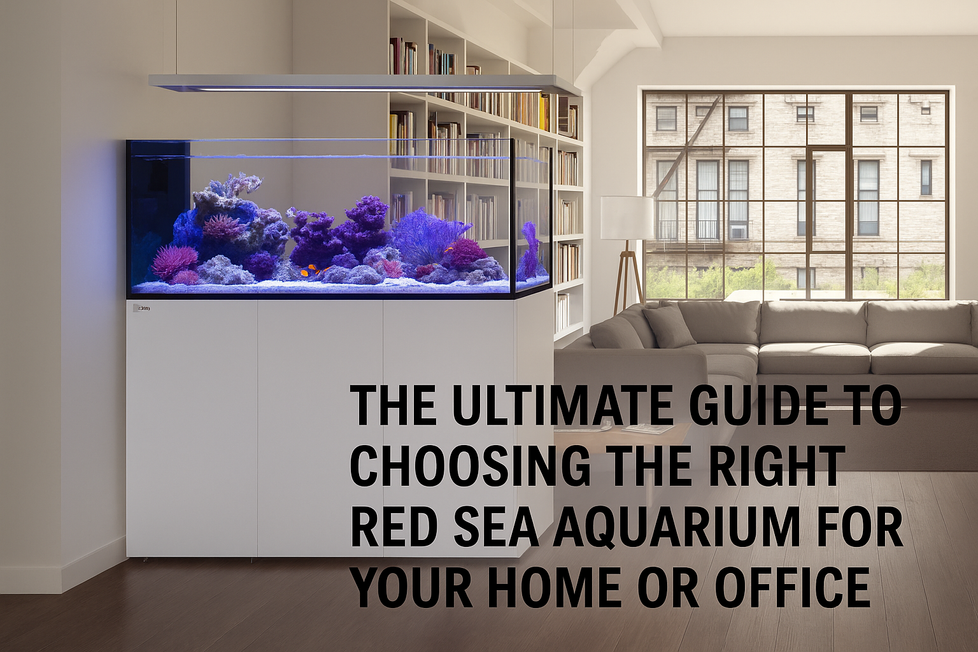Algae growth is a common challenge for reef aquarium owners. While some algae are beneficial, excessive growth can harm your tank's inhabitants and spoil its appearance. Fortunately, several strategies can help manage and eliminate unwanted algae. This blog will cover effective tips for getting rid of algae in a reef aquarium, with product recommendations from Charterhouse Aquatics.
1. Maintain Proper Lighting
Overview: Overexposure to light can promote algae growth. Ensure your aquarium receives the correct amount of light and consider using a timer to regulate light periods.
Tips:
- Limit lighting to 8-10 hours per day.
- Use LED lights designed for reef tanks to reduce excess heat and light intensity.
Recommended Product: AquaI llumination Prime 16HD Reef LED - This LED light provides customisable lighting options suitable for reef aquariums, helping to control algae growth.
2. Regular Water Changes
Overview: Regular water changes help remove excess nutrients that fuel algae growth. Aim for a 10-20% water change weekly.
Tips:
- Use high-quality salt mixes to maintain water chemistry.
- Siphon out detritus and algae during water changes.
Recommended Product: Red Sea Coral Pro Salt - This salt mix helps maintain optimal water conditions for reef tanks.
3. Control Nutrient Levels
Overview: High levels of nitrates and phosphates can lead to algae blooms. Test and maintain these nutrients within recommended levels.
Tips:
- Use phosphate removers and nitrate reducers if necessary.
- Avoid overfeeding and promptly remove uneaten food.
Recommended Product: Seachem PhosGuard - This product helps control phosphate levels, reducing algae growth.
4. Add Algae-Eating Invertebrates and Fish
Overview: Certain invertebrates and fish can help keep algae under control by grazing on it.
Tips:
- Introduce species like snails, crabs, and algae-eating fish.
- Ensure they are compatible with your tank inhabitants.
Recommended Product: Turbo Snail - Turbo snails are excellent algae grazers that can help keep your tank clean.
5. Use Protein Skimmers
Overview: Protein skimmers remove organic waste before it breaks down into nitrates and phosphates, reducing algae growth.
Tips:
- Choose a protein skimmer suitable for your tank size.
- Regularly clean and maintain the skimmer for optimal performance.
Recommended Product: Ultra-Reef Akula UKS-160 Protein Skimmer - This skimmer is efficient at removing organic waste, helping to maintain water quality.
6. Implement a Refugium
Overview: A refugium can help control algae by providing a space for beneficial macroalgae to grow, which competes with nuisance algae for nutrients.
Tips:
- Light the refugium on an opposite schedule to the main tank to stabilize pH levels.
- Regularly harvest macroalgae to export nutrients from the system.
Recommended Product: Eheim Aquaball 130 Internal Filter- This internal filter can be used as a refugium to help manage nutrient levels.
7. Maintain Proper Flow
Overview: Good water circulation prevents dead spots where algae can thrive and helps distribute nutrients and oxygen.
Tips:
- Use powerheads to create adequate water movement.
- Position them to eliminate dead spots and promote even flow.
Recommended Product: EcoTech Marine VorTech MP40 - This powerhead offers excellent flow control for reef tanks.
Conclusion
Algae management is a crucial aspect of maintaining a healthy and beautiful reef aquarium. By implementing these strategies and using the right products, you can effectively control algae growth and ensure a thriving marine environment. Explore the range of high-quality products at Charterhouse Aquatics to support your algae control efforts and keep your reef tank in top condition.
For more expert advice and top-quality aquarium products, trust Charterhouse Aquatics to help you achieve a pristine and healthy reef aquarium.


